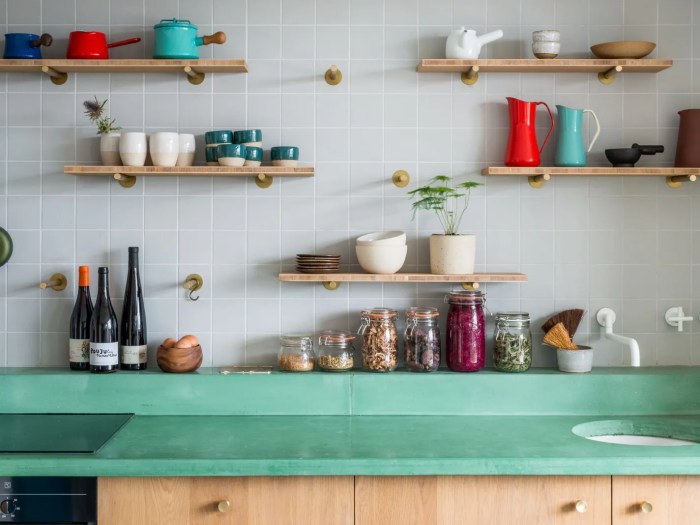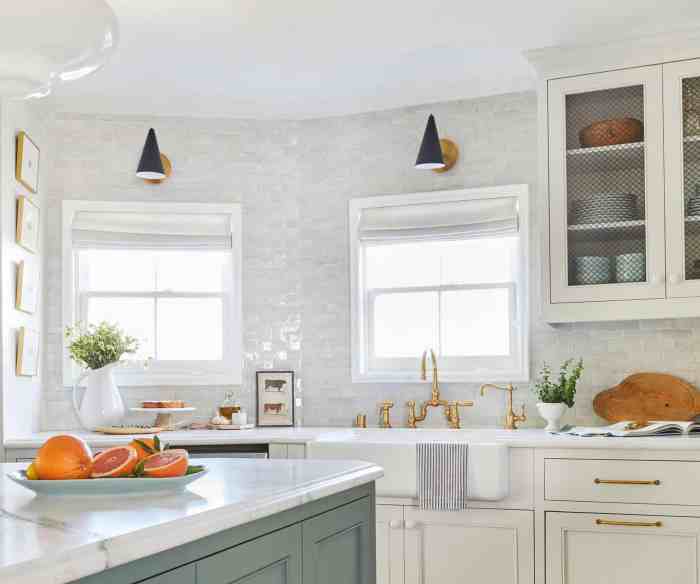Minimalist Kitchen Design

Simple kitchen decor ideas – A minimalist kitchen prioritizes functionality and clean lines, creating a space that is both aesthetically pleasing and highly efficient. This design philosophy focuses on removing clutter and unnecessary items, leaving only essential elements to contribute to a calm and organized cooking environment. We’ll explore the key aspects of achieving this streamlined and sophisticated look.
Simple kitchen decor often hinges on clever use of existing items. A fresh coat of paint can work wonders, but for a truly unique touch, consider transforming your everyday tools into art. One surprisingly effective method is to create a stunning focal point by hanging your favorite utensils; check out this guide on kitchen utensil wall decor for inspiration.
This adds both practicality and personality, perfectly complementing other simple decor choices like a vibrant tablecloth or a few strategically placed potted herbs.
Minimalist design in the kitchen isn’t just about aesthetics; it’s about creating a space that supports your workflow and reduces stress. By carefully selecting materials and furniture, and implementing strategic organization, you can transform your kitchen into a haven of efficiency and calm.
Minimalist Kitchen Design Concept
This concept emphasizes a neutral color palette, high-quality materials, and carefully selected furniture pieces. The goal is to create a space that feels both spacious and inviting, without sacrificing functionality. The overall effect is one of serenity and order, reflecting a mindful approach to cooking and daily life.
The following elements are crucial in creating a minimalist kitchen:
- Color Palette: A neutral palette forms the foundation, utilizing shades of white, gray, beige, or light wood tones. Accents of a single, bold color—perhaps a deep teal or a muted green—can be incorporated sparingly for visual interest.
- Materials: High-quality, durable materials are preferred. Think sleek stainless steel appliances, natural stone countertops (like quartz or marble), and matte-finish cabinetry in wood or a high-quality laminate. Avoid overly ornate or textured materials.
- Key Furniture Pieces: Essential furniture includes simple, clean-lined cabinetry, a large, uncluttered island (if space allows), and comfortable bar stools. Avoid excessive ornamentation or decorative details on the furniture.
Decluttering and Organizing a Minimalist Kitchen
Effective decluttering and organization are paramount to achieving a minimalist aesthetic in the kitchen. This process involves a systematic approach to removing unnecessary items and implementing storage solutions that maximize space and minimize visual clutter.
A step-by-step guide to decluttering and organizing your kitchen for a minimalist look:
- Empty the Kitchen: Remove everything from your cabinets, drawers, and countertops. This allows for a thorough assessment of what you truly need and use.
- Sort and Purge: Categorize items into three piles: keep, donate/sell, and discard. Be ruthless in your assessment; if you haven’t used an item in the past six months, it’s likely unnecessary.
- Deep Clean: Once items are removed, thoroughly clean the cabinets, drawers, and countertops. This provides a fresh start for your organized space.
- Strategic Storage: Utilize vertical space with shelves and drawers. Employ clear containers for pantry items to easily see contents. Utilize drawer dividers and organizers to maximize space and keep items neat.
- Maintain the Minimalist Approach: Regularly declutter and re-evaluate your kitchen items to prevent the accumulation of unnecessary items. A “one in, one out” rule can be helpful.
Benefits and Challenges of Minimalist Kitchen Décor
Adopting a minimalist approach to kitchen décor offers several advantages, but also presents certain challenges. The benefits outweigh the challenges for those committed to a streamlined and efficient cooking space.
The benefits and challenges are intertwined and require careful consideration:
- Benefits: A minimalist kitchen promotes a sense of calm and order, improves efficiency by providing easy access to frequently used items, and creates a more spacious feeling, even in smaller kitchens. The clean lines and neutral palette create a visually appealing and sophisticated space.
- Challenges: Maintaining a minimalist kitchen requires consistent effort in decluttering and organizing. It may require investing in high-quality, durable storage solutions, which can be costly. Some may find the lack of decorative elements or personal touches to be less welcoming or expressive of their personality.
Lighting and its Impact: Simple Kitchen Decor Ideas

Effective kitchen lighting is crucial for both functionality and ambiance. A well-lit kitchen is safer, more efficient, and more inviting than one that is poorly lit. The strategic use of different lighting types can dramatically alter the mood and atmosphere of even the simplest kitchen design.
Different types of lighting—ambient, task, and accent—each play a distinct role in creating a well-lit and functional kitchen space. Ambient lighting provides overall illumination, task lighting focuses light on specific work areas, and accent lighting highlights architectural features or decorative elements. The interplay of these three types creates a layered and dynamic lighting scheme that caters to various needs and moods.
Ambient Lighting in Simple Kitchens
Ambient lighting sets the overall mood and provides a general level of illumination throughout the kitchen. It’s the foundation upon which task and accent lighting are built. In a simple kitchen, a central ceiling fixture, such as a flush-mount or semi-flush mount light, can serve as the primary source of ambient lighting. The visual effect is a soft, even glow that prevents harsh shadows and ensures comfortable visibility across the entire space.
Recessed lighting is another excellent option, offering discreet and uniform illumination.
Task Lighting for Kitchen Functionality
Task lighting is specifically designed to illuminate work areas where precision and visibility are paramount. In a kitchen, this typically includes the countertops, sink, and stovetop. Under-cabinet lighting is a popular choice, casting a focused light on the countertops, reducing shadows, and making food preparation easier and safer. Pendant lights above an island or peninsula provide focused illumination for a central work area.
The visual effect of task lighting is a bright, focused beam of light that enhances visibility and reduces eye strain during food preparation and cleaning.
Accent Lighting to Enhance Kitchen Aesthetics
Accent lighting highlights specific features or decorative elements to add visual interest and depth. In a simple kitchen, accent lighting can be used to draw attention to a unique backsplash, a display of cookbooks, or a striking piece of artwork. Track lighting allows for flexible placement of spotlights, enabling precise illumination of chosen areas. Small spotlights or LED strip lights can be installed inside cabinets or under shelves to create a dramatic effect.
The visual effect of accent lighting is a targeted beam of light that draws the eye to specific features, creating visual interest and enhancing the overall aesthetic appeal.
Three Lighting Schemes for Simple Kitchens
The following examples demonstrate how different combinations of lighting can create distinct atmospheres:
- Scheme 1: Warm and Inviting: This scheme utilizes warm-toned LED recessed lighting for ambient illumination, complemented by under-cabinet task lighting with a similar warm tone. Accent lighting consists of small LED strip lights installed inside glass-fronted cabinets, casting a soft glow on displayed items. The overall mood is cozy and welcoming, ideal for casual gatherings and family dinners.
- Scheme 2: Modern and Bright: This scheme features bright white LED recessed lighting for ambient illumination, supplemented by bright white LED under-cabinet task lighting. Accent lighting is provided by track lighting with adjustable spotlights, highlighting architectural details and artwork. The overall ambiance is clean, modern, and functional, suitable for a contemporary kitchen design.
- Scheme 3: Rustic and Charming: This scheme uses a central pendant light with a rustic finish as the primary ambient light source. Task lighting is provided by a combination of under-cabinet lighting and a small pendant light above the sink. Accent lighting consists of strategically placed wall sconces with warm-toned bulbs. The overall mood is rustic, charming, and inviting, suitable for a farmhouse-style kitchen.
Natural Light and Window Treatments, Simple kitchen decor ideas
Natural light is a valuable asset in any kitchen, providing ample illumination and creating a bright and airy atmosphere. Maximizing natural light involves strategically placing windows and choosing appropriate window treatments. Sheer curtains or blinds allow ample natural light to filter through while maintaining privacy. Heavier curtains or blinds offer more control over light levels, allowing for adjustment depending on the time of day and desired ambiance.
The impact of natural light on kitchen design is significant, contributing to a more energy-efficient and visually appealing space. Proper window treatments ensure that natural light enhances the kitchen without compromising privacy.
Clarifying Questions
Can I use dark colors in a small kitchen?
Dark colors can work in a small kitchen if used strategically. Focus on dark colors on one wall or accent pieces, and balance them with lighter colors and plenty of lighting to avoid making the space feel cramped.
How can I add personality without spending a lot?
Repurpose items you already own, add personal photos or artwork, use colorful towels and dishcloths, and incorporate plants to bring life and personality to the space.
What’s the best way to organize open shelving?
Group similar items, vary heights and sizes for visual interest, and use baskets or containers to corral smaller items. Consider color coordination for a cohesive look.
How important is lighting in kitchen design?
Lighting is crucial! It impacts both the functionality and mood of the kitchen. Layer different types of lighting (ambient, task, accent) to create a well-lit and inviting space.
